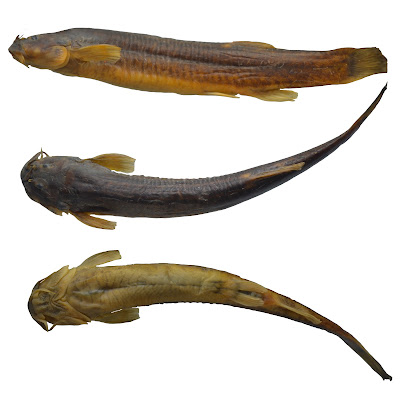 |
| Trichomycterus puna Fernández, Contrera & Bize, 2023 |
Abstract
Trichomycterus puna, new species, is described from a small tributary of the Corral Blanco in Catamarca Province, Argentina, as part of an ongoing systematic study of the genus Trichomycterus from the High Andean Plateau or Altiplano-Puna drainages of the southern Central Andes. The new species is distinguished from congeners by the following characters: the odontodes embedded in thick integument that covers interopercle, the premaxillary bone smaller than maxilla, the presence of sesamoid supraorbital with lateral process, the supraorbital sensory pore s3 present, the discontinuous supraorbital sensory canal, 2–3 premaxillary tooth rows, the uniformly dark pigmentation on the trunk, 15 precaudal vertebrae, the skin of trunk with minute thread-like papillae, 7–8 pectoral-fin rays, 9–12 dorsal procurrent caudal-fin rays, 10–11 ventral procurrent caudal-fin rays, the distally unbranched barbels, the wider interorbital distance, 16 pairs of ribs, the first dorsal-fin pterygiophore inserting on vertebra 18, and the first anal-fin pterygiophore inserting on vertebra 21. It closely resembles T. alterus, T. belensis, T. boylei, and T. ramosus from the Puna region. Trichomycterus belensis and T. catamarcensis are recorded from new localities over 3,400 m elevation.
 |
| Trichomycterus puna, holotype, FACEN 151, 74.1 mm SL, Argentina, Provincia Catamarca, Departamento Bele´n, El Angosto creek. |
Trichomycterus puna, new species
Etymology.—The specific epithet puna is a noun in apposition and is attributable to the geological province known as
the Puna. The origin of the word is Quechuan and is attributable to the indigenous people known as the Kollas who
lived in this area.
Luis Fernández, Guadalupe Contrera and Julieta Andreoli Bize. 2023. New Species of Trichomycterus (Siluriformes: Trichomycteridae) from Wetlands of High Elevation of Argentina, with Notes on the T. alterus Species-Complex. Ichthyology & Herpetology. 111(3); 456-466. DOI: 10.1643/i2022074